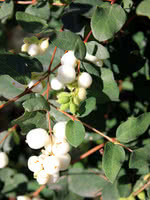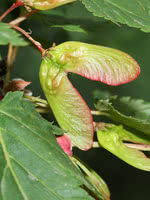Mon-Fri 9am - 5pm Mountain time
Common Snowberry vs Douglas Maple
Symphoricarpos albus
Acer glabrum
CUSTOM GROW
Common Snowberry is a small deciduous shrub with characteristic white to pink flowers and clusters of white fruit.
This North American native species is very adaptable, and can be used for erosion control in riparian and restoration areas. Snowberry's fruit attracts wildlife, and livestock can consume the berries without issue.
Douglas Maple is a fast growing, long lived, ornamental tree. It can take on a shrubby or multi-stemmed form with densely packed leaves, making it an excellent tree for privacy screens and hedges.
In the fall, the leaves make a brilliant change to red, orange, or yellow depending on the tree and its sun exposure. Douglas Maple's compact size makes it ideal for planting in urban yards and under power lines.
Common Snowberry Quick Facts
Douglas Maple Quick Facts
Toxicity: berries toxic to humans

